Army Ranks
Army ranks are a system of “hierarchical” relationships in the United States Army. Hierarchical relationships create arrangements in which people are represented as being “above”, “below”, or “at the same level as” one another. Subsequently, the Army ranks defines dominance, authority, and responsibility in the United States Army hierarchy.
The Army’s rank system incorporates the principles of exercising power and authority creating what we call the Army chain of command. This chain of command forms the line of authority and responsibility through which orders and information are passed within the Army. Simply put, ranks identify the succession of leaders through which command is exercised and executed. Ranks play an important role in structure of Army branches along with both the employment and deployment of units, vehicles, and weapons.

Ranks and Rank insignia
Ranking systems, historically, have proven to bring many advantages to military operations. Some of the areas in which these advantages are most obvious are the areas of logistics, command, and coordination among others. Army ranks and rank insignia have changed over time. As Army operations became increasingly more complex, the ranks and rank insignia became more complex as well.
Normally, Army uniforms identify the wearer’s ranks with certain rank insignias affixed to the uniforms. It is not only used to designate leadership, but also to establish the officer or soldier’s pay-grade as well. As the ranks increase, the pay-grades increase. Logically, the amount of responsibility increases as well.
Ranks are often confused with pay grades. In truth, pay grades are administrative classifications used primarily to standardize compensation across the Army and other military services. Pay grades are comprised of a letter and a number. The letter indicates the type of service while the number indicates the level of the pay grade for those ranks. The pay categories are “E” for enlisted, “W” for warrant officers, and “O” for commissioned officers. It should be noted that, some enlisted pay grades have two or more ranks at that level.
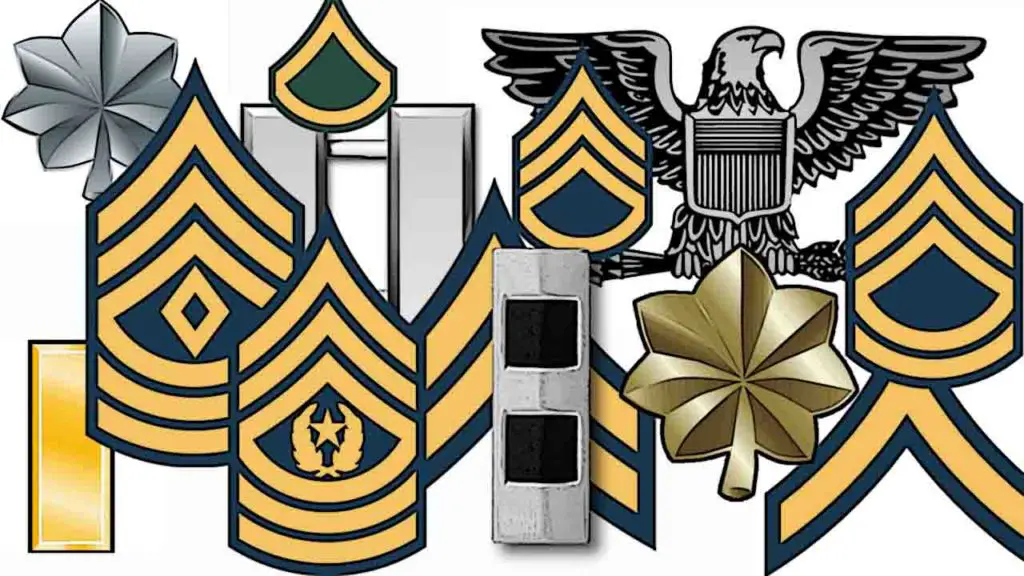
Click Here to scroll down to a complete table of Army Ranks.
Enlisted Ranks
United States Army enlisted personnel are non-commissioned soldiers that have specialties within the Army. Enlisted personnel perform specific job functions. Additionally, they have the knowledge, skills and abilities to ensure the success of their unit’s mission.
Army enlisted ranks promotions are typically controlled by using two metrics; time in service (TIS) and time in grade (TIG). Time in service is the total accumulated time of military service of the soldier. Time in grade is the amount of time a soldier has served in their current pay grade. It should be noted that TIS and TIG are the base requirements and variations within the Army start to occur for promotions to ranks at pay grades E-5 and up, often as a result of the soldier’s military occupational specialty (MOS). The number of positions requiring NCO ranks that are needed has a huge effect.
Enlisted promotions for ranks at pay grades E-5 and up vary according to a “zone” system. These zones are known as the “primary zone” and the “secondary zone”. The Primary Zone is the regular time requirements under which a soldier can be considered for promotion at a promotion board. Secondary Zone consideration is reserved for exceptional soldiers that stand out and are deemed worthy of being considered for promotion at an earlier time frame than most soldiers. Additionally, demand for soldiers of NCO ranks can create a need to consider soldiers for promotion under the secondary zone.
Private (PVT)
The rank of Private is the lowest rank in the United States Army. Most enlisted soldiers begin their careers as a private. Some, however, are granted a higher rank based on previous training or experience. This is why the Private rank is typically associated with the term “recruit”. The Private rank does not have a rank insignia.
Private Insignia
None
Private Pay Grade
The pay grade for the rank of Private is E-1. There are no Time in Service or Time in Grade requirements to be achieve this rank.
Private Second Class (PV2)
The United States Army enlisted rank of Private Second Class is one rank above Private and is the first promotional rank that can be achieved after enlisting in the Army. Soldiers of this rank are still addressed as Private.
Private Second Class Insignia
 The Private Second Class rank insignia is a single chevron. A common nickname for the insignia is “mosquito wings”.
The Private Second Class rank insignia is a single chevron. A common nickname for the insignia is “mosquito wings”.
Private Second Class Pay Grade
The pay grade of a Private Second Class is E-2. A Private E-1 is automatically promoted to Private E-2 after 6 months Time in Service. Early promotion is possible after 4 months of Time in Service if a waiver is obtained. Certain previous training or experience may also allow an enlisted soldier to begin their career at the Private Second Class rank instead of as a Private.
Private First Class (PFC)
The United States Army enlisted rank of Private First Class is one rank above Private Second Class and is the second promotional rank that can be achieved after enlisting in the Army. Soldiers of this rank are still addressed as Private. The rank of Private First Class is usually earned at a soldier’s first duty station after having completed basic combat training and advanced individual training.
Private First Class Insignia
 The Private first class rank insignia is comprised of a single chevron and a rocker stripe.
The Private first class rank insignia is comprised of a single chevron and a rocker stripe.
Private First Class Pay Grade
The pay grade for the rank of Private First Class is E-3. A Private Second Class is automatically promoted to Private First Class after 12 months of Time in Service and 4 months of Time in Grade as an E-2. Early promotion is possible after 6 months of Time in Service and 2 months of Time in Grade as an E-2 if a waiver is obtained.
Specialist (SPC)
The United States Army enlisted rank of Specialist is one rank above Private First Class and one rank below Corporal. It is the highest junior enlisted rank. After promotion to Specialist, soldiers may increasingly be called upon to manage lower ranked soldiers and take on more responsibility. Those with a four year college degree can enter the Army immediately as a Specialist. The Specialist and Corporal ranks share the same pay grade.
Specialist Rank Insignia
 The rank of Specialist in the United States Army is denoted by a yellow gold Crest of the United States eagle on olive green cotton in the shape of an inverted chevron and rocker stripe.
The rank of Specialist in the United States Army is denoted by a yellow gold Crest of the United States eagle on olive green cotton in the shape of an inverted chevron and rocker stripe.
Specialist Pay Grade
The pay grade for the rank of Specialist is E-4. Private First Class is automatically promoted to the rank of Specialist and pay grade E-4 after 24 months of Time in Service and 6 months of Time in Grade as an E-3. In some cases (waiver) promotion can occur with 18 Months Time in Service and with 3 months Time in Grade as an E-3.
Corporal (CPL)
The United States Army rank of Corporal is one rank above the rank of Specialist although both ranks share the same pay grade. It is the lowest Non-Commissioned Officer (NCO) rank and is considered a junior NCO. Soldiers holding the rank of Corporal fulfill the leadership role as leaders of a small teams. They are responsible for the team’s training, personal appearance, and cleanliness. This rank serves as the base of the NCO ranks.
Corporal Insignia
 The Corporal rank insignia is comprised of two chevrons.
The Corporal rank insignia is comprised of two chevrons.
Corporal Pay Grade
The pay grade for the rank of Corporal is E-4. Private First Class may be promoted to the rank of Corporal and pay grade E-4 after 24 months of Time in Service and 6 months of Time in Grade as an E-3. In some cases (waiver) promotion can occur with 18 Months Time in Service and with 3 months Time in Grade as an E-3. A specialist may be promoted laterally to the Rank of Corporal. For advancement to Corporal most units require the soldier to hold a leadership position, such as a team leader.
Sergeant (SGT)
The United States Army rank of Sergeant is one rank above the rank of Corporal. The Sergeant is usually placed in a leadership position such as team or squad leader. Usually, a Sergeant is assigned soldiers that he or she is directly responsible for. They are directly responsible for the training, cleanliness, personal appearance, and accountability of their subordinate soldiers. It is the first of the Army’s enlisted ranks to be referred to as “Sergeant” along with the ranks of Staff Sergeant, Sergeant First Class, and Master Sergeant.
Sergeant Insignia
 The Sergeant rank insignia is comprised of three chevrons.
The Sergeant rank insignia is comprised of three chevrons.
Sergeant Pay Grade
The pay grade for the rank of Sergeant is E-5. A soldier holding the Specialist or Corporal ranks may be promoted to the rank of Sergeant in either the Primary or Secondary zones. A Primary zone promotion is possible after a board appearance, after 34 months of Time and Service, and six months of Time in Grade as an E-4. The earliest that a primary zone promotion can occur is after 36 months of Time in Service with at least eight months of Time in Grade as an E-4.
A secondary zone promotion to Sergeant is possible after a board appearance, 16 months of Time in Service, and 4 months of Time in Grade as an E-4. The earliest a secondary zone promotion to Sergeant can occur is at 18 months of Time in Service with 6 months of Time in Grade as an E-4.
Staff Sergeant (SSG)
The United States Army rank of Staff Sergeant is one rank above the rank of Sergeant. Soldiers with the rank of Staff Sergeant often serve as Squad and/or Section leaders. Staff Sergeants mentor new Sergeants snd are typically more experienced than newly promoted NCOs. They are expected to be more effective leaders as well. Sometimes, Staff Sergeants are directly responsible for Privates, Specialists, and NCOs of lower ranks. They conduct evaluations of subordinate NCOs. As with the other leadership ranks, how well the Staff Sergeant ensures the accountability, appearance, and training of soldiers at subordinate ranks reflects on their leadership ability.
Staff Sergeant Insignia
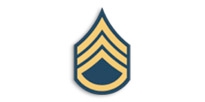 The Staff Sergeant rank insignia is comprised of a three chevrons and a rocker stripe.
The Staff Sergeant rank insignia is comprised of a three chevrons and a rocker stripe.
Staff Sergeant Pay Grade
The pay grade for the rank of Staff Sergeant is E-6. A Sergeant may be promoted to the rank of Staff Sergeant in either the Primary or Secondary zones. A Primary zone promotion is possible after a board appearance, after 72 months of Time and Service, and 8 months of Time in Grade as an E-5. The earliest that a primary zone promotion can occur is after 72 months of Time in Service with at least 10 months of Time in Grade as an E-5.
A secondary zone promotion to Staff Sergeant is possible after a board appearance, 46 months of Time in Service, and 5 months of Time in Grade as an E-5. The earliest a secondary zone promotion to Staff Sergeant can occur is at 48 months of Time in Service with 7 months of Time in Grade as an E-5.
Sergeant First Class (SFC)
The United States Army rank of Sergeant First Class is one rank above the rank of Staff Sergeant. Staff Sergeants often serve as Platoon Sergeants where they assist the Platoon Leader. Additionally, they lead the platoon during the absence of the platoon leader. Usually, Sergeants First Class are in charge of lower NCO ranks and must delegate and assign authority to them in order to complete the mission. A Sergeant First Class is the first NCO rank to be considered a senior NCO. They conduct evaluations of subordinate NCOs and guide them in ensuring the accountability, appearance, and training of soldiers at subordinate ranks.
Sergeant First Class Insignia
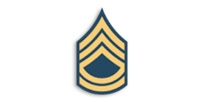 The Sergeant First Class rank insignia is comprised of a three chevrons and two rocker stripes.
The Sergeant First Class rank insignia is comprised of a three chevrons and two rocker stripes.
Sergeant First Class Pay Grade
The pay grade for the rank of Sergeant First Class is E-7. A Staff Sergeant may be promoted to the rank of Sergeant First Class in either the Primary or Secondary zones. Primary Zone consideration begins at around 35 months Time in Grade as an E-6 while secondary zone promotion requirements vary based on the needs of the Army. The DA Secretariat conducts the Army’s Senior NCO promotion boards from Sergeant First Class to Sergeant Major, and the Command Sergeant Major CSL boards. Law (Title 10, USC) and Army policies govern the selection board process.
Master Sergeant (MSG)
The United States Army Master Sergeant rank is one rank above the rank of Sergeant First Class. Master Sergeants typically serve as a principle staff NCO at the battalion and higher levels. Although not assigned with the same amount of leadership responsibility as the First Sergeant, the Master Sergeant shares the same pay grade. Master Sergeants are still charges with effectively leading soldiers directly under their charge. Master Sergeant is the most senior enlisted rank to be referred to as “Sergeant” although some may prefer to be addressed as “Master Sergeant.”
Master Sergeant Insignia
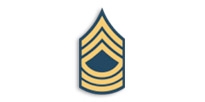 The Master Sergeant rank insignia is comprised of a three chevrons and three rocker stripes.
The Master Sergeant rank insignia is comprised of a three chevrons and three rocker stripes.
Master Sergeant Pay Grade
The pay grade for the rank of Master Sergeant is E-8. A Sergeant First Class may be promoted to the rank of Master Sergeant in either the Primary or Secondary zones. Primary Zone consideration begins at around 41 months Time in Grade as an E-7 while secondary zone promotion requirements vary based on the needs of the Army. The DA Secretariat conducts the Army’s Senior NCO promotion boards from Sergeant First Class to Sergeant Major, and the Command Sergeant Major CSL boards. Law (Title 10, USC) and Army policies govern the selection board process.
First Sergeant (1SG)
The United States Army First Sergeant rank is one rank above the rank of Sergeant First Class.They share the same pay grade as the Master Sergeant but A First Sergeant is generally senior to a master sergeant in leadership matters. In some cases, a master sergeant may have more general military authority such as when in charge of a military police (MP) section. First Sergeants are charged with holding formations, directing the platoon sergeants, and advising the commander of the company. They also assist in the training of all enlisted soldiers. First Sergeants are not referred to as “Sergeant”, instead, they are to be referred to as “First Sergeant”.
First Sergeant Insignia
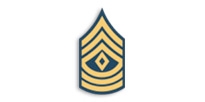 The First Sergeant rank insignia is comprised of a three chevrons and three rocker stripes with a pierced lozenge in the center.
The First Sergeant rank insignia is comprised of a three chevrons and three rocker stripes with a pierced lozenge in the center.
First Sergeant Pay Grade
The pay grade for the rank of First Sergeant is E-8. A Sergeant First Class may be promoted to the rank of First Sergeant in either the Primary or Secondary zones. Primary Zone consideration begins at around 41 months Time in Grade as an E-7 while secondary zone promotion requirements vary based on the needs of the Army. A Master Sergeant may also be laterally promoted to the rank of First Sergeant.
The DA Secretariat conducts the Army’s Senior NCO promotion boards from Sergeant First Class to Sergeant Major, and the Command Sergeant Major CSL boards. Law (Title 10, USC) and Army policies govern the selection board process. In addition, the First Sergeant must be filling a slotted role as First Sergeant of a unit.
Sergeant Major (SGM)
The United States Army Sergeant Major is the principle staff NCO at levels higher than the battalion.The Sergeant Major and Command Sergeant Major ranks share the same pay grade. The difference between the ranks of Sergeant Major and Command Sergeant Major is similar to the difference between the Master Sergeant and the First Sergeant. Although the rank of Sergeant Major denotes less leadership responsibility than a Command Sergeant Major, a Sergeant Major is still responsible for exercising leadership of those soldiers and NCOs that are directly in their charge.
Sergeant Major Insignia
 The Sergeant Major rank insignia is comprised of a three chevrons and three rocker stripes with a five-pointed star in the center.
The Sergeant Major rank insignia is comprised of a three chevrons and three rocker stripes with a five-pointed star in the center.
Sergeant Major Pay Grade
The pay grade for the rank of Sergeant Major is E-9. A Master Sergeant or First Sergeant may be promoted to the rank of Sergeant Major in either the Primary or Secondary zones. Primary Zone consideration begins at around 34 months Time in Grade as an E-8 while secondary zone promotion requirements vary based on the needs of the Army.
The DA Secretariat conducts the Army’s Senior NCO promotion boards from Sergeant First Class to Sergeant Major, and the Command Sergeant Major CSL boards. Law (Title 10, USC) and Army policies govern the selection board process.
Command Sergeant Major (CSM)
The United States Army Command Sergeant Major is the senior enlisted advisor to the commanding officer of a battalion size unit or higher. They advise the unit commander and give recommendations when appropriate. Command Sergeant Majors serve as monitors of, and advocates for, the enlisted soldiers in the command. Additionally, they ensure policies and procedures are being followed and that standards are being met. They are responsible for the overall training, cleanliness, personal appearance, and accountability of all soldiers within the unit. The Command Sergeant Major also has certain ceremonial responsibilities such like caring for the unit’s colors (flag).
Command Sergeant Major Insignia
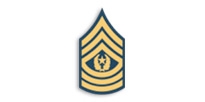 The Command Sergeant Major rank insignia is comprised of a three chevrons and three rocker stripes with a five-pointed star with a wreath around it in the center.
The Command Sergeant Major rank insignia is comprised of a three chevrons and three rocker stripes with a five-pointed star with a wreath around it in the center.
Command Sergeant Major Pay Grade
The pay grade for the rank of Command Sergeant Major is E-9. A Master Sergeant or First Sergeant may be promoted to the rank of Command Sergeant Major in either the Primary or Secondary zones. Primary Zone consideration begins at around 34 months Time in Grade as an E-8 while secondary zone promotion requirements vary based on the needs of the Army.
The DA Secretariat conducts the Army’s Senior NCO promotion boards from Sergeant First Class to Sergeant Major, and the Command Sergeant Major CSL boards. Law (Title 10, USC) and Army policies govern the selection board process. In addition, a Command Sergeant Major must be filling a slotted CSM position in a battalion or high level unit.
Sergeant Major of the Army (SMA)
Unlike all other United States Army enlisted ranks, the Sergeant Major of the Army is a unique non-commissioned rank and position of office in the United States Army. The Sergeant Major of the Army rank is one rank above the rank of Command Sergeant Major. They are the most senior enlisted member of the Army, unless an Army enlisted man is serving as the senior enlisted advisor to the Chairman of the Joint Chiefs of Staff.
The Sergeant Major of the Army is responsible for overseeing all Army NCOs in regards to training, cleanliness, personal appearance, and accountability of all soldiers throughout the United States Army. Interestingly, even though the Sergeant Major of the Army is a non-commissioned officer, protocol places them higher than all lieutenant generals (except for the Director of the Army Staff) and equivalent to a general for formal courtesies in addition to seating, billeting, transportation, and parking.
Sergeant Major of the Army Insignia
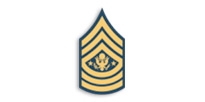 The Sergeant Major of the Army rank insignia is comprised of a three chevrons and three rocker stripes with the eagle from the Great Seal of the United States between two five-pointed stars in the center.
The Sergeant Major of the Army rank insignia is comprised of a three chevrons and three rocker stripes with the eagle from the Great Seal of the United States between two five-pointed stars in the center.
Sergeant Major of the Army Pay Grade
The pay grade for the rank of Sergeant Major of the Army is E-9. The Sergeant Major of the Army rank is a special / ceremonial rank. Promotions do not occur in the same way as with other traditional Army ranks. Instead, the Chief of Staff of the Army (CSA) and the Secretary of the Army personally select the Sergeant Major of the Army from a pool of qualified Sergeants Major.
The Sergeant Major of the Army receives a special rate of basic pay that is higher than all other sergeants major.

Warrant Officer Ranks
In the United States Army, there are 5 warrant officer ranks. The pay grades for the warrant officer ranks go from the pay grade of W‑1 to pay grade W‑5. Warrant officers ranks are above all enlisted personnel ranks as well as officer candidates and cadets. All warrant officer ranks are subordinate to the lowest officer rank of Lieutenant.
Army personnel holding warrant officer ranks are highly skilled, single-track specialty officers. Warrant officer ranks are authorized by Congress and present throughout the military branches but each of the uniformed services selects, manages, and uses warrant officers in slightly different ways. Both warrant officers and chief warrant officers take the same oath as regular commissioned officers.
Warrant officers advance through progressive levels of expertise in assignments, training, and education. They administer, manage, maintain, operate, and integrate United States Army systems and equipment across the entire span of Army operations. Officially, (regardless of rank) warrant officers are addressed as Mr., Mrs., Miss, or Ms.). Unofficially, Chief Warrant Officers can be, and have been, informally addressed as “Chief”.
Warrant Officer (WO1)
The United States Army Warrant Officer focuses on becoming proficient and working on those systems linked directly to their AOC/MOS, that is, their area of concentration (officer AOC), or enlisted ranks military occupational specialty (MOS). Warrant officers are classified by warrant officer military occupational specialty, or WOMOS. As they become experts on the systems they operate and maintain, their focus migrates to integrating their systems with other branch systems.
Warrant Officer Insignia
 The Warrant Officer rank insignia is comprised of a silver bar with one black square.
The Warrant Officer rank insignia is comprised of a silver bar with one black square.
Warrant Officer Pay Grade
The pay grade for the rank of Warrant Officer is W-1. The Warrant Officer is appointed by warrant with the requisite authority pursuant to assignment level and position given by the Secretary of the Army.
Chief Warrant Officer 2 (CW2)
The United States Army Chief Warrant Officer 2 focuses on increasing proficiency and working on those systems linked directly to their AOC/MOS, that is, their area of concentration (officer AOC), or enlisted ranks military occupational specialty (MOS). The Chief Warrant Officer 2 is classified by warrant officer military occupational specialty, or WOMOS. As experts on the systems they operate and maintain, they continue to focus on integrating their systems with other branch systems.
Chief Warrant Officer 2 Insignia
 The Chief Warrant Officer 2 rank insignia is comprised of a silver bar with two black squares.
The Chief Warrant Officer 2 rank insignia is comprised of a silver bar with two black squares.
Chief Warrant Officer 2 Pay Grade
The pay grade for the rank of Chief Warrant Officer 2 is W-2. The Chief Warrant Officer 2 is a commissioned officer with the requisite authority pursuant to assignment level and position as given by the President of the United States.
Chief Warrant Officer 3 (CW3)
The United States Army Chief Warrant Officer 3 is an advanced level technical and tactical expert. They perform the primary duties of technical leader, trainer, operator, manager, maintainer, sustainer, integrator, and advisor. The Chief Warrant Officer 3 also performs any other branch-related duties that are assigned to them. As they become more senior, their focus becomes integrating branch systems into larger Army systems.
Chief Warrant Officer 3 Insignia
 The Chief Warrant Officer 3 rank insignia is comprised of a silver bar with three black squares.
The Chief Warrant Officer 3 rank insignia is comprised of a silver bar with three black squares.
Chief Warrant Officer 3 Pay Grade
The pay grade for the rank of Chief Warrant Officer 3 is W-3. The Chief Warrant Officer 3 is a commissioned officer with the requisite authority pursuant to assignment level and position as given by the President of the United States.
Chief Warrant Officer 4 (CW4)
The United States Army Chief Warrant Officer 4 is a senior-level technical and tactical expert. They perform the duties of technical leader, manager, maintainer, sustainer, integrator, and advisor and serve in a wide variety of branch level positions. As they become more senior, the Chief Warrant Officer 4 focuses on integrating branch and Army systems into joint and national-level systems.
Chief Warrant Officer 4 Insignia
 The Chief Warrant Officer 4 rank insignia is comprised of a silver bar with four black squares.
The Chief Warrant Officer 4 rank insignia is comprised of a silver bar with four black squares.
Chief Warrant Officer 4 Pay Grade
The pay grade for the rank of Chief Warrant Officer 4 is W-4. The Chief Warrant Officer 4 is a commissioned officer with the requisite authority pursuant to assignment level and position as given by the President of the United States.
Chief Warrant Officer 5 (CW5)
The United States Army Chief Warrant Officer 5 is a master-level technical and tactical expert. They perform the primary duties of technical leader, manager, integrator, and advisor. They are the senior technical experts in their branches and serve at brigade and higher levels. The Chief Warrant Officer 5 may also serve as Command Chief Warrant Officers (CCWO) for large commands at the brigade level and higher.
Chief Warrant Officer 5 Insignia
 The Chief Warrant Officer 5 rank insignia is comprised of a silver bar with a vertical black stripe.
The Chief Warrant Officer 5 rank insignia is comprised of a silver bar with a vertical black stripe.
Chief Warrant Officer 5 Pay Grade
The pay grade for the rank of Chief Warrant Officer 5 is W-5. The Chief Warrant Officer 5 is a commissioned officer with the requisite authority pursuant to assignment level and position as given by the President of the United States.
Officer Ranks
United States Army Commissioned officers are the managers, problem solvers, key influencers and planners of the Army who lead enlisted soldiers in all types of situations. Those in the Officer ranks are responsible for planning missions, giving orders and assigning soldier tasks. Commissioned officers are often assisted by personnel from the non-commissioned officer ranks in accomplishing these tasks.
There are several different ways to become a commissioned officer. Some of the paths include; the United States Military Academy (USMA), the Reserve Officers’ Training Corps (ROTC), Officer Candidate School (OCS), and Direct Commissioning. Direct Commissioning refers to certain professions who are commissioned directly into the Army based on specialized need like physicians, pharmacists, nurses, lawyers and chaplains and are directly commissioned at the rank specified by their branch. Regardless of which path a person takes to become an officer, all Army officers at particular ranks wear the same insignia.

The United States Army offers three promotion opportunities for officers: Below-the-Zone, In-the-Zone, and Above-the-Zone. Below-the-Zone only applies for promotion to the ranks of Major, Lieutenant Colonel, and Colonel. Below-the-Zone refers to eligibility for promotion one year prior to the normal In-the-Zone consideration, about 10 percent of those recommended can be promoted Below-the-Zone, however, most promotions occur In-the-Zone. The selection rate for Above-the-Zone promotion refers to promotion after the normal In-the-Zone consideration and only occurs in about 3 percent of cases.
Two additional and important factors in promotion through the officer ranks are fitness reports and the nature of their current and past assignments. A poor fitness report may cause an officer to be passed over for promotion. An officer whose previous assignments were not of significant responsibility may also be passed over.
Second Lieutenant (2LT)
Most officers enter the Army at second lieutenant. They lead platoon-size units consisting of a platoon sergeant and two or more squads (16 to 44 Soldiers). The Second lieutenant is a junior commissioned officer.
Second Lieutenant Insignia
 The Second Lieutenant rank insignia is comprised of a gold-colored bar. In United States Army slang terminology, the Second Lieutenant rank is sometimes called “butterbar”.
The Second Lieutenant rank insignia is comprised of a gold-colored bar. In United States Army slang terminology, the Second Lieutenant rank is sometimes called “butterbar”.
Second Lieutenant Pay Grade
The pay grade for the rank of Second Lieutenant is O-1. The Second Lieutenant rank is granted upon receiving a commission under presidential authority.
First Lieutenant (1LT)
The United States Army First Lieutenant is one level above Second Lieutenant. The difference between the Second Lieutenant and First Lieutenant ranks is slight. The main differences between the two are experience and a higher pay grade. Often, Lieutenants are moved to positions requiring more experience after promotion. For example, a Second Lieutenant may lead a specialty platoon or be assigned as the executive officer for a company-sized unit. The Second lieutenant is a junior commissioned officer.
First Lieutenant Insignia
 The First Lieutenant rank insignia is comprised of a silver-colored bar.
The First Lieutenant rank insignia is comprised of a silver-colored bar.
First Lieutenant Pay Grade
The pay grade for the rank of First Lieutenant is 0-2. A Second Lieutenant may be promoted to the rank of First Lieutenant at around 18 months of Time in Service and 18 months Time in Grade as an 0-1.
Captain (CPT)
The United States Army Captain is one level above First Lieutenant. The captain commands and controls company-sized units (62 to 190 Soldiers). When a Captain commands a company, they are referred to as a “Company Commander”. U.S. Army Special Forces (12-member) Operational Detachments Alpha are also commanded by a captain, who has the title of “Detachment Commander.” He or she may also instruct at service schools and combat training centers or serve as a staff officer at the battalion level. The Captain is a junior commissioned officer.
Captain Insignia
 The Captain rank insignia is comprised of two silver-colored bars. This insignia is often affectionately described as “railroad tracks”.
The Captain rank insignia is comprised of two silver-colored bars. This insignia is often affectionately described as “railroad tracks”.
Captain Pay Grade
The pay grade for the rank of Captain is 0-3. A First Lieutenant may be promoted to the rank of Captain at around 4 (+1) years of Time in Service and 2 years of Time in Grade as an 0-2.
Major (MAJ)
The United States Army Major typically serves as a battalion executive officer (XO) or as the battalion operations officer (S3). Majors can also serve as Company Commanding Officers. Additionally, a major can also serve as a primary staff officer for a regiment, brigade or task force unit in the areas concerning personnel, logistics, intelligence, and operations. A major will also be a staff officer / action officer on higher staffs and headquarters. Additionally, majors command augmented companies in Combat Service and Service Support units. The Major is a senior commissioned officer.
Majors in the United States Army also command Special operations companies, such as Special Forces companies, Civil Affairs companies, Military Information Support Operations companies, and certain types of separate Military Intelligence companies.
Major Insignia
 The Major rank insignia is comprised of a golden oak leaf.
The Major rank insignia is comprised of a golden oak leaf.
Major Pay Grade
The pay grade for the rank of Major is 0-4. A Captain may be promoted to the rank of Major at around 10 (+/- 1) years of Time in Service and 3 years of Time in Grade as an 0-3.
Lieutenant Colonel (LTC)
The United States Army Lieutenant Colonel is one level above the rank of Major. They typically command battalion-sized units (300 to 1,000 Soldiers) with a command sergeant major as an NCO assistant. He or she may also be selected for brigade and task force executive officer. The ranks of Lieutenant Colonel and Colonel are both simply referred to as “colonel” in conversation and in unofficial correspondence. The Lieutenant Colonel is a senior commissioned officer.
Lieutenant Colonel Insignia
 The Lieutenant Colonel rank insignia is comprised of a silver oak leaf.
The Lieutenant Colonel rank insignia is comprised of a silver oak leaf.
Lieutenant Colonel Pay Grade
The pay grade for the rank of Lieutenant Colonel is O-5. A Major may be promoted to the rank of Lieutenant Colonel at around 16 (+/- 1) years of Time in Service and 3 years of Time in Grade as an 0-4.
Colonel (COL)
The United States Army Colonel rank is one level above the rank of Lieutenant Colonel. They typically command brigade-sized units (3,000 to 5,000 Soldiers), with a command sergeant major as principal NCO assistant. They may also serve as the chief of divisional-level staff agencies. The Colonel is the highest of the senior officer ranks.
Colonel Insignia
 The Colonel rank insignia is comprised of a silver eagle which is a stylized representation of the eagle dominating the Great Seal of the United States.
The Colonel rank insignia is comprised of a silver eagle which is a stylized representation of the eagle dominating the Great Seal of the United States.
Colonel Pay Grade
The pay grade for the rank of Colonel is O-6. A Lieutenant Colonel may be promoted to the rank of Colonel at around 22 (+/- 1) years of Time in Service and 3 years of Time in Grade as an 0-5.
Brigadier General (BG)
The Brigadier General rank is one level above the rank of Colonel. The Brigadier General serves as deputy commander to the commanding general for Army divisions. This rank is responsible for overseeing the staff’s planning and coordination of a mission. The Brigadier General is the lowest of the General officer ranks.
Brigadier General Insignia
 The Brigadier General rank insignia is comprised of a silver five pointed star.
The Brigadier General rank insignia is comprised of a silver five pointed star.
Brigadier General Pay Grade
The pay grade for the rank of Brigadier General is O-7. A Lieutenant Colonel may be promoted to the rank if younger than 62 years old and have completed a Joint Duty Assignment tour in which they commanded units made up of service members from two or more branches of the United States military. In addition, candidates for the general officer ranks will be reviewed by a specific promotion board primarily concerned with promotions within the General Officer ranks. Past accomplishments, leadership roles, and the needs of the Army will be considered.
If determined by the promotion board, a recommendation for promotion into the general officer ranks will be made to the President of the United States. If the President accepts this recommendation they will nominate the officer for promotion. The Presidential nomination must be confirmed by the United States Senate.
Major General (MG)
The United States Army Major General is one level above the rank of Brigadier General. This rank is the highest permanent peacetime rank in the uniformed services as higher ranks are technically temporary and linked to specific positions, although virtually all officers promoted to those ranks are approved to retire at their highest earned rank. The major general typically commands division-sized units (10,000 to 15,000 Soldiers). The Major General may also serve as training center commanders, joint task force commanders, deputy commanding generals to 3-star generals, chief of staff in 4-star commands, senior directors on Army and joint staffs, and, in the case of the Army National Guard, as The Adjutant General (TAG) for their state, commonwealth or territory.
Major General Insignia
 The Major General rank insignia is comprised of two silver five pointed stars.
The Major General rank insignia is comprised of two silver five pointed stars.
Major General Pay Grade
The pay grade for the rank of Major General is O-8. A Brigadier General may be promoted to the rank of Major General after review by a specific promotion board primarily concerned with promotions within the General Officer ranks. Past accomplishments, leadership roles, and the needs of the Army will be considered.
If determined by the promotion board, a recommendation for promotion to the Major General rank will be made to the President of the United States. If the President accepts this recommendation they will nominate the officer for promotion. The Presidential nomination must be confirmed by the United States Senate.
Lieutenant General (LTG)
The United States Army Lieutenant General is one level above the rank of Major General. They typically command a corps-sized unit (20,000 to 45,000 soldiers). Additionally, the Lieutenant General may serve as high-level staff officers at various major command headquarters and The Pentagon, Typically, they are the heads of their departments.
Lieutenant General Insignia
 The Lieutenant General rank insignia is comprised of three silver five pointed stars.
The Lieutenant General rank insignia is comprised of three silver five pointed stars.
Lieutenant General Pay Grade
The pay grade for the rank of Lieutenant General is O-9. The Lieutenant General rank is a temporary rank and is linked to the position of a particular office. General officers may only be promoted to this rank if they are appointed to positions that require them to hold it. The Lieutenant General rank expires with the expiration of the term of office. The term of office is usually set by statute.
Lieutenant generals are nominated for appointment by the president from any eligible officers holding the rank of brigadier general or above, who also meet the requirements for the position and with the advice of the Secretary of Defense and the Chairman of the Joint Chiefs of Staff. The nominee must be confirmed via majority vote by the Senate before they can take office and assume the rank. The standard tour length for most lieutenant general positions is three years but some are set four or more years by statute.
General (GEN)
The United States Army General is one level above the rank of Lieutenant General. It is the highest general officer rank in peacetime. The Chief of Staff and the Vice Chief of Staff of the United States Army are both Generals.
General Insignia
 The General rank insignia is comprised of four silver five pointed stars.
The General rank insignia is comprised of four silver five pointed stars.
General Pay Grade
The pay grade for the rank of General is O-10. The General rank is a temporary rank and is linked to the position of a particular office. General officers may only be promoted to this rank if they are appointed to positions that require them to hold it. The General rank expires with the expiration of the term of office. The term of office is usually set by statute.
Generals are nominated for appointment by the president from any eligible officers holding the rank of brigadier general or above, who also meet the requirements for the position and with the advice of the Secretary of Defense and the Chairman of the Joint Chiefs of Staff. The nominee must be confirmed via majority vote by the Senate before they can take office and assume the rank. The standard tour length for most General positions is three years but some are set four or more years by statute.
General of the Army (GOA)
The United States Army General of the Army rank is only achievable in times of war, where the commanding officer must be equal or of higher rank than those commanding armies from allied nations. The last officers to hold this rank served during and immediately following World War II.
General of the Army Insignia
 The General of the Army rank insignia is comprised of five stars in a pentagonal pattern, with points touching.
The General of the Army rank insignia is comprised of five stars in a pentagonal pattern, with points touching.
General of the Army Pay Grade
The pay grade for the rank of General of the Army is O-10. The General of the Army rank is another of the temporary ranks and is only achievable during times of war.
No officers have been appointed to the rank of General of the Army since Omar Bradley. The rank of General of the Army is still maintained as one of the ranks of the Army, and could again be bestowed. However, the President, with Senate approval, may award a fifth star at any time that it is deemed appropriate.

Ranks and Rank Insignia Table
[table id=1]